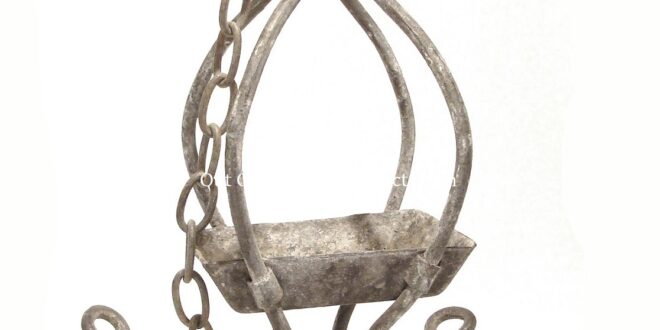French Miners Pit Head Baths Suspended Clothes Basket.
Made from galvanised iron. Size 12″ x 5″ x 4″ inches.
The Pithead Baths Story.
The idea of pithead baths in the UK had been mentioned as early as 1889 though they were not really seen to be taken seriously until just before WW1. They were in use in Germany in 1891.
In October 1913 the matter received consideration of the Miners Federation and the miners at the Arrael Griffin Colliery, Six Bells had a meeting where the miners agent Mr W Brace chaired and tried to convince the workers that a pithead baths would really be in their interest and that the Section 77 of the Coal Mines Act of 1911 enacts that if a majority of the men at a colliery wanted a baths the owners would have to make satisfactory provisions and build one, the cost would be shared, half by the owners and half by the men at a rate of no more than 1 farthing a day – 1 1/2d per week. A ballot would be held at a later date but Mr Brace hoped the men would agree and vote yes.
In June 1914 a report declared and reaffirmed the Section 77 of the Coal Mines Act of 1911, collieries exempt from this section of the act are those employing 100 men or less, those collieries whose leases terminate within 10 years or which are likely to be worked out within that time. The cost of maintenance must be shared and the management of the baths is entrusted to a committee of six, three representing the coal owners and three the colliers.
The report stated that the reason why there is lack of support for a pithead baths is that a very small proportion of miners have any notion as to what a pithead baths really are! So a brief description may serve to dispel the wrong ideas which prevail as to the workings of the system.
Descriptive Example… What follows is a descriptive account of a typical pithead baths prior to the introduction of cabinet lockers – A miner proceeds to work in his ordinary suit, his working clothes are in the bath house, suspended by means of a chain passing over a pair of pulley’s near the roof of the building. To prevent his clothes being stolen each man is provided with a padlock and key. On entering the house the miner unlocks his padlock, his chain ascends and his clothes descends. He makes his necessary change in a private compartment, hangs his clothes to the hook at the end of the chain and hoists them to the roof and locks his padlock…. When he reaches the surface at the end of his shift he takes down his ordinary clothes and passes into a bathing cabinet – this is a compartment 5ft 6ins long by 3ft 6ins wide and 6ft high.
It is constructed of glazed brick or iron, the opening is screened by a waterproof curtain or a door. The cabinet is divided into two portions, the outer portion is for dressing or undressing, the inner for bathing operations to take place.
A sink connecting to a drain occupies the centre of the floor and overhead at a height of 7ft-8ft is the spray – a length of hot water pipe connected with the mains and terminating in a rose 4ins-6ins in diameter. The spray is provided with a valve manipulated by either pulling a cord, pressing a lever or turning a wheel. When this valve is opened the bather receives a shower bath. He lathers himself with a small bar of soap provided by the coal company, 1 bar per man per day. After his bath he dries himself with a towel provided to him one per week or whenever deemed necessary. He then proceeds to the dry section of the cabinet and finishes dressing.
There are to be one cabinet for every 6 men employed on the maximum shift and the time taken in the cabinet is no longer than 5 to 7 minutes, when he has finished he hoists his dirty clothes to the roof and they are dried by the hot air of the baths before his next shift begins.
From this brief account any principal objections are without foundation, there is little or no delay, each man has secured privacy, clothes cannot be stolen, danger from infections or diseases are at a minimum and the drying arrangements are so efficient that the risk of illness from wearing damp garments is almost negligible. On the continent owners are compelled by law to install baths and in Germany the men are compelled to use them. In France and Belgium baths are optional though between 75 and 90 percent of the men use them.
The pithead baths campaign had every confidence that even larger percentages would be recorded in South Wales once the system came into general use. The need for the moment is for an active propaganda to be carried on in it’s favour and was desirable that the Miners Federation should initiate the educational campaign so that its members may be in the position to take the necessary steps to put Section 77 into full operation.
This campaign seemed to come to a halt as war broke out in 1914 and was re-started in 1920, urged on by many women’s organisations, after the war there were many stoppages and discontent in the coalfield and I can’t find out much about its progress until 1931 when Rose Heyworth Colliery leased by the Ebbw Vale Company opened the first pithead baths in the Western Valley’s. At this time there were 54 such baths being contemplated and only 5 completed with Rose Heyworth being one of those five.
 Out Of The Blue Artifacts A Library of a lifetime of collecting
Out Of The Blue Artifacts A Library of a lifetime of collecting
